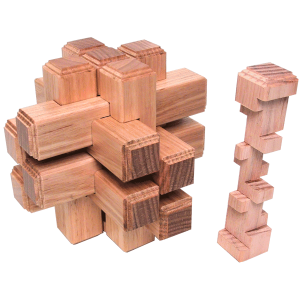The Nine Bars Puzzle #62
1 December 2011Craftsman Range puzzle made in December 2011 12 made. All sold. Original Price: AU$100.00 9 hexagonal sticks & 9 dowels. Some different lengths. Four stick-dowel…


The name of this burr comes from the spiral structure that is created by the 8 pieces surrounding the central 5 piece core.
This burr features what Bill Cutler considers to be the most interesting disassembly sequence he has ever created. From the time I’ve spent ‘playing’ with the puzzle during manufacture, I have to agree. It’s very different and quite an enjoyable challenge.
A true collector’s item. There were originally just 20 puzzles made by Jerry McFarland and sold from 1990-1992. Bill himself had earlier made and sold a smaller number of puzzles and to this day regrets that he even sold his last production model in 1994. So you can see this puzzle is very rare, and after this 30 we will never make it again either.
Because of the way this puzzle works it has been necessary to work to extremely fine tolerances when machining the pieces. Like all the puzzles we make, this puzzle has been lacquered inside and out to help maintain this precision. Each individual piece of our Limited Edition puzzles is buffed and waxed as well.
This puzzle made under license to Bill Cutler. General Information from Bill Cutler’s official publication of 1983. This information reproduced with the kind permission of Bill Cutler.
The name comes from the spiral nature of the main pieces. The basic design was thought up in the summer of 1982 and was originally intended to become the Wausau ’82 puzzle, however, the design quickly became too complex. The puzzle was formally introduced at the Sixth Annual International Puzzle Party at Jerry Slocum’s house on April 2, 1983. The first solution was received from Edward Hordern.
The puzzle has many notches which are 1/3 and 1/4 the width of the rods so that problems of tolerance and humidity changes are magnified. In addition, the very nature of the way the puzzle was intended to disassemble makes these problems worse still, and the likelihood of having incorrect methods of disassembly increases.
To top this off Stan Isaacs discovered a way to disassemble the original puzzle which was clearly a ‘bug’ (error). The bug was corrected by minor changes to two pieces.
Wood used: Tasmanian Oak. Not a member of the oak family at all but rather a eucalypt. The name Tasmanian Oak was originally used by early European timber workers who believed the eucalypts showed the same strength as English Oak. Size: 150mm x 150mm x 150mm (13 pieces, each 30mm x 30mm)